
(Photos M.Andersen/BikePortland)
This post is part of our special focus on east Portland this week.
When people talk about using “traffic calming” to design a “commercial greenway” — like the one proposed for NE 28th Avenue — it sometimes comes off as a strange, experimental sort of magic that we’d probably have to visit Europe to understand.
But we don’t. Most Portlanders — most Americans — walk or drive through areas that are models of safely shared space almost every day of our lives. But we don’t call them greenways or woonerfs or home zones.
We call them parking lots.
So far this week, we’ve talked a lot about things east Portland could learn from central Portland. Now let’s put the shoe on the other foot.
Because the Walmart at SE 82nd and Holgate lot sits entirely on private property, and therefore isn’t subject to the same design rules created for public roads in the mid-20th century, the people who designed its parking lot (whoever they were) were free to do everything they could think of to help people share space with cars without thinking twice about it.
It works perfectly.
It’s not that Walmart’s parking lot is as comfortable for walking or biking as a sidewalk or a park. Nowhere with rolling motor vehicles could be. But it’s as safe and comfortable as you’ll ever feel while sharing a street with cars. Because when you’re walking through a parking lot, that’s exactly what you’re doing.
Here are a few of the ingredients that designers of future human-friendly commercial streets might keep in mind — or head over to 82nd and Holgate to check out for themselves.
1) People are constantly walking in every direction.
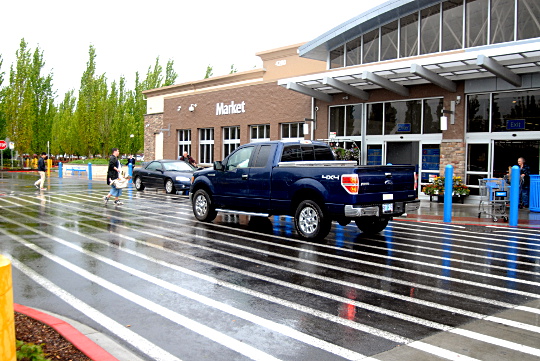
The huge striped area in front of Walmart’s front door isn’t textured (though that’s a cool trick used by some other parking lots). It’s not signed. It’s not elevated. It’s just striped. And everyone who uses it seems to understand it perfectly — mostly because people are using it nonstop. I never saw a motor vehicle move more than 10 mph through this area, because its drivers were always on the lookout for something unexpected. When cars are moving at the speed of bikes, it’s no problem for them to negotiate naturally with everyone else on the road.
Advertisement
Peter Norton’s book Fighting Traffic tells the story of how automotive interest groups led a national campaign in the 1910s and 1920s to create the idea of “jaywalking.” Instead, city dwellers were ordered in the name of safety to remain in carefully engineered paths. The effect: urban car speeds rose dramatically.
Spend five minutes in Walmart’s parking lot and you might get a sense of how much was at stake when our great-grandparents fought that battle, which mostly ended the days when people just walked in whatever direction they were headed. Speaking of which…
2) There are no curbs.
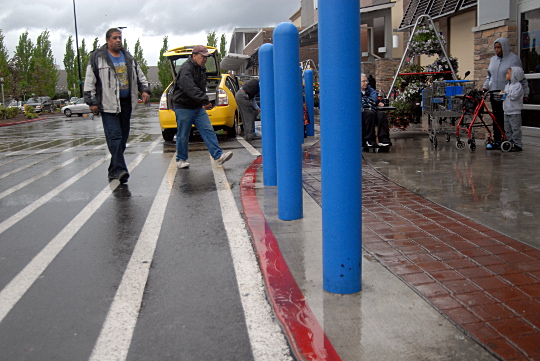
OK, this is probably in part to facilitate the great American tradition of wheeling your shopping cart directly to the trunk of your car. But curblessness (aided here by a brick stripe that could be felt by a white-tipped cane) is part of the magic that transforms this pavement from an ordered street into a freewheeling shared space.
You know where else you’ve seen this design, using curbless streets and posts to give people permission to scatter in every direction, blurring the line between sidewalk and street? Downtown Portland’s nationally celebrated architectural jewel, Director Park:

It works there. And it works here, too.
3) The walls have nooks, and the nooks have benches.
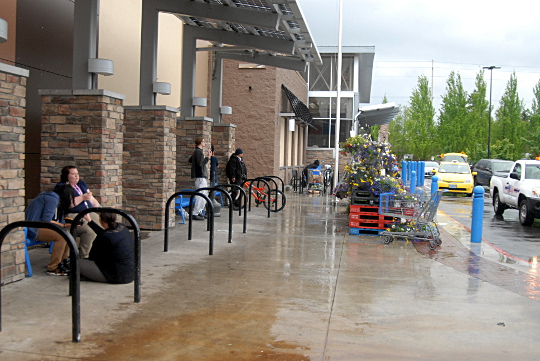
Again, these were probably included for a totally commercial purpose: they’re a good place to wait for a ride. But they have a social purpose, too, creating a public space where you can sit and talk in a part of town that isn’t set up for such things.
In architect-speak, these pillars and benches “activate the space” between Walmart’s entrances, further increasing the ratio of humans to cars in front of the store and giving people a place to enjoy things they just bought.
4) The crosswalks are elevated.
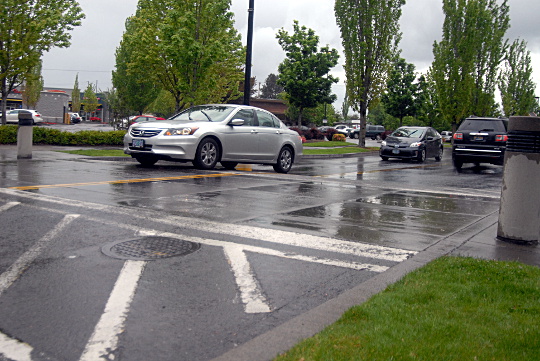
Further from Walmart’s front door, where walking is rarer and cars are more dominant, the parking lot reverses its no-curbs trick: it raises the crosswalks to sidewalk level.
This is an idea that’s been much discussed on 28th Avenue but generally understood to be impossible, even if the crossings are raised by a single inch, because 28th Avenue is designated as an emergency response corridor. (I was once told, within the span of a minute, that one-inch-high crosswalks are pointless because drivers don’t notice them, and also that they’re dangerous because they jostle the IV needles of people in ambulances.)
These concerns are probably valid on some streets. I don’t know how much damage a raging fire can do in the seconds it’d take for a fire truck to slow down to cross one of these crosswalks, or the cost of those seconds when an ambulance is racing toward a stroke victim. But I do know that raising a crosswalk by six inches has a radical effect on the behavior of people driving — and on people’s sense that this is a safe place to not be inside a car.

Obviously Walmart is a ruthlessly profit-driven company, and it certainly didn’t order its parking lot to be designed so carefully in order to reduce auto traffic — it probably did it to reduce injury lawsuits and to prevent people from having unpleasant experiences while attempting to give Walmart their money.
But that’s exactly the point. Traffic calming isn’t about reducing auto traffic or driving cars off the street. It’s about reducing injuries. And it’s about making places more pleasant to live, work and (yes) spend money in. In a city that says its top priority for 28th Avenue is to help local businesses continue to make money, there might be a lot we could all learn from Walmart.
The idea for this post came from local writer Jeff Mapes’ 2009 book Pedaling Revolution, in which he compared Dutch woonerfs to spaces outside “apartment complexes, where playing children, chatting neighbors, and carefully moving cars shared the parking lot.”

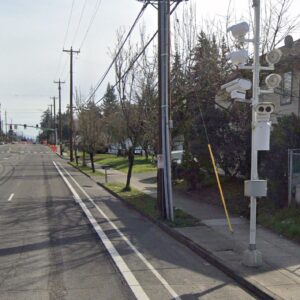
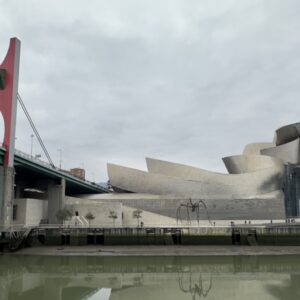


I like this take. As a corollary, the idea of car-free shopping districts in Portland seems outrageous to some folks, until you compare them to the car-free shopping districts we’re already familiar with, like the inside of a mall, or the Woodburn outlets, or Fremont Street in Vegas, which had 5 blocks closed off to car traffic 20 years ago as part of a plan to bring in more business.
“It works perfectly.”
Absolutely not. Parking lots are exhibit 1 as to why shared spaces do not work.
Would anyone ever allow their kid (under 10) to walk alone, without being firmly grasped by the hand? Absolutely not. On a sidewalk? Of course.
Do people walk in the middle of the aisle, care free? Absolutely not, people are pushed off to the sides so the larger vehicles can pass.
Are they SAFE? Sure. I can’t recall the last time I read about a parking lot death. But are they comfortable? Absolutely not.
And one glaring error: “and therefore isn’t subject to the same design rules created for public roads in the mid-20th century”
Im unsure about Portland, but most US cities have very strict, very detailed, and very specific rules about parking lot design. In most suburbs, the parking lot design guide is bigger than the street design guide. From aisle widths to stall widths to lighting, to trees, to access points….everything is defined strictly. Why does the Walmart parking lot in X city have one tree per 4 stalls while the one in Y city have none? Local regulations. Etc etc.
I appreciate the disagreements, JJJJ. As I wrote in the paragraph that follows “it works perfectly,” I am not comparing parking lots to sidewalks. I’m comparing them to other spaces that cars use.
Also, on the design standard issue: I didn’t say parking lots aren’t subject to design standards. I said they’re not subject to the same ones. Designs that AASHTO and MUTCD would forbid on a roadway are allowed in a parking lot. That’s a policy choice.
Out of curiosity, does anyone know if (at least newer) Walmart’s around the country have similar parking lot designs? My guess is there might be a bit more pressure for good design here in PDX, but do people in Arkansas, where non-auto transport is likely a lower priority, get a similar experience?
Hi Alan, Walmart lots in Kansas City and Fayetteville AR feature similar designs. (In fact, a very large bike race stages and starts in a Walmart lot in Fayetteville!)
The one in Woodland, WA has a similar design. I like the parking lots that provide the walkway between the parked cars better. I agree that the shared space in a parking lot is not comfortable, even if it is safe.
Google/Bing/Whatever maps let you do some of the research on-line of other places and other chains. You don’t get traffic humps, but you can get road paint, and sometimes (streetview) pictures of the pickup areas.
Here’s a nearby Home Depot: http://goo.gl/maps/OVClU
The Target slightly to the north is less traffic-engineered.
Here’s a Home Depot and Costco in Waltham, showing even more extensive ped cross-hatch for the Home Depot, and not much at all for the Costco (tsk, tsk).
I know in Utah they do – and I’ve been to all 12 in Salt Lake City. All the same.They tend to bit off the highest ADA and federal road guidelines so they dont have to get specific for each state and county and city. That’s how cookie cutters work. Gets them up quick and still allows them to get as much real estate as possible, which often is where the profit is in.
The one in Steamboat Springs Colorado does not (though I suspect the Walmart went into a pre-existing building.)
I find “suburban” (for lack of a better term) parking lots to be for more stressful to drive in than to walk in – and that’s probably for the best, but I also find myself muttering under my breath at others to slow down – it’s a parking lot, pal! – to me it’s self evidently a pedestrian zone with a high likelihood for expensive fender benders, many other drivers are a lot more blithe in their approach.
I saw a few in rural Kansas and Missouri when I rode across the country a few years ago (2010). I don’t remember the stripes or elevated crosswalks (they could’ve been there, but I didn’t make a note of it), but they did all feature benches and very wide sidewalks/walkways in front of the stores. Not unpleasant places to stop and rest.
I’ve stopped at a lot of Walmarts for groceries while trucking (one of the few place you can reliably get a 53′ trailer & tractor in and out of easily) and these design features seem to be exclusive to newer construction sites; probably less than 5 years old.
When I drive to a grocery store, I always look for a shopping cart that someone has abandoned because it’s too inconvenient to push to where it is supposed to be returned. I almost always find a cart.
As I push the cart to the store down or across the drive aisles, I avoid making direct eye contact with drivers (I watch them out of the corner of my eye) and boldly push the cart to the entrance. By pretending to be oblivious to the auto’s presence, I put the burden on the motorist to yield. Because of the cart, they always do. I guess they don’t want to damage their vehicle by hitting a cart. Some motorists appear content to let a pedestrian without a cart simply jump out of the way.
Try it to see if it works for you.
I always do this at Costco. I observe a 100% yielding rate when I’m pushing a 20lb metal cart.
I’m male and older, so that may make a difference, and have a crazy looking beard and mustache, so that may make a difference, but I make eye contact with the drivers and give them a look that says to the best of my ability “I’m going there. Stay out of my way!”
It works just fine, for me.
A thought provoking piece. Thanks, Michael. I guess one fly in the ointment is that Walmarts have displaced the shops we all used to be able to walk or bike to (whether we did or not, they were proximate).
“Traffic calming isn’t about reducing auto traffic or driving cars off the street. It’s about reducing injuries.”
I’d be inclined to say that it is or should be about all of the above, but I guess we can agree to disagree about that part.
I’m siding with Michael on this one. Traffic calming is not about diverting traffic from a street. It is about modifying the behavior of motorist using a street, and that is all PBOT ever should imply. Diverters are about reducing traffic on a particular street.
Wow, I think Walmart owes me a consulting fee. 🙂
There are a couple of beefs I have with the implementation – particularly where they block the pedestrian refuge paths in front of the garden center. Also, a lot of the ped /car conflicts are lessened when they keep the south entrance (around the corner facing Holgate) open. But, they’ve decided that they don’t want to do that anymore.
Great points.
In addition, to what extent do drivers yield to people on foot in a parking lot because they identify with them? (After parking, they themselves will be walking into the store and will want people in cars to yield to them.)
This phenomenon doesn’t happen as much in other environments (like the streets of East Portland or Washington County) because many people driving through those spaces have not experienced the same space on foot, and driving through an intersection does not trigger in their memory the experience of standing on the street corner waiting to cross or crossing and hoping not to be hit. (I think that calls, then, for more areas to be designed in ways that necessitate experiencing them on foot even if you mostly drive.)
In the same way that I think every single patron who visits a restaurant should have to “do time” being a server for a couple of weeks, perhaps every single driver should “do time” being a pedestrian for a few weeks too.
We’d see a massive upsurge in crosswalk compliance from motorists, you could be sure of that!!
“…more areas to be designed in ways that necessitate experiencing them on foot…” Peter W
That would be a wrong, negative approach towards providing conditions in parking lots that would be safer for walking and that would invite people to walk, rather than having them resort to some of the typical parking lot habits. For example, people in their cars cruising round and round, the rows of filled parking spaces closest to store’s entrance, waiting for someone walking to their car to get in and make a space available.
As I touched on in a comment yesterday, businesses having parking lots designed for their customers’ cars, overwhelmingly seem to choose not to devote any space but the absolute minimum required to provide their customers with appealing and functional sidewalks. Instead, they seem to devote every possible square foot of space to the parking of cars. So it is, often in huge parking lots where only thirty percent or so of the lot’s spaces are occupied with cars, people are cruising the rows closest to the entrance looking for a space closer in, so they don’t have to walk in the parking lot.
People don’t like walking in parking lots that function like they’re only built for cars to be driven in. Out in Beaverton at the big mall, Winco has done a fair job with thermoplastic stripes, of designating a very prominent crosswalk across the main mall road between the store’s entrance and the parking lot beyond. People driving do respect people using that crosswalk. This main road also has abrupt speed bumps, which also help. Here too though, at least two, maybe three spacious and attractive sidewalks running the length of the parking area, could encourage people to feel far better about parking a bit further away from the store’s entrance, which would likely help to ease congestion on the mall’s main road. This could be a business trade off in terms of not providing quite as much space for cars to be parked, with a resulting loss of business, but maybe not.
It’s interesting that private developers have no problem implementing mixed-use schemes that give priority to human-scale traffic. The private street in our HOA is functionally a Woonerf. No sidewalks, signs or curbs, indeed no streetlights. The kids (including mine) play in the middle of the street with no worries. Everyone walks down the middle of the street and everyone else drives appropriately.
Contrast that to downtown Fairview, OR – the worst place I’ve seen to walk, ride a bike, or drive a car.
For all their faults, Walmart does seem to make an effort to be accessible. In fact, in Eugene, they were willing to work with a BRT project to convert part of the parking lot into a small bus station with a turnaround.
this is a perfect example of what drivers don’t want, for the road to be reduced to a parking lot…
This is so true. I’m currently in England studying how cyclists ride through shared space intersections. The comments I’ve heard include anger that these new intersections are now slower slower slower and that drivers don’t like that! (It ‘puts them off’, I’m being told.) Followed, ironically, by acknowledgement that the intersection is MUCH safer than it was before. And then…cue the scofflaw cyclist rant. Sigh.
You have missed one VERY important point here. Back a few years ago….AFTER the 80’s bikeway was built, this commercial node got the building permits to expand their parking lot/ Build another big box store on the SE corner. This is the connection from the “Central 80’s” greenway between the mall and Powell to the southern leg just north of Holgate.
My concern is less about traffic calming, but conductivity. To get to this southern leg you have to ride a narrow sidewalk with right turns…..directly NEXT to the NEW parking lot they built AFTER the 80’s bikeway went in. The city did not even require them to upgrade the active transportation connection. No one but locals know it is there.
Paying attention to development in “East-gate Mall” Is even in the 2030 Bike Master Plan because of this connection….yet, BDS approved their permits without making ANY improvements to this bike connection just a few feet away…..which connects the Gladstone-Cernter greenway directly with the 80’s. As usual, Portland only builds it 90% of the way then stops.
You can not make the BUSINESS COMMUNITY actually pay for anything or they may not create jobs!! Oh NO, not that!!
I was shocked at this incompetence…as I watched them built the new parking lot and kept expecting them to upgrade this terrible connection.
You can also see this same situation but worse behind the Fubon to the north. The newly built, curbed and paved section of 85th directly behind Fubon has a small entrance to the back parking lot that has no curb cut-out, no sidewalk and was not upgraded for bikes. This would have created a quality connection from the end of the Woodward-Clinton Greenway to the 80’s….but again, the city dropped the ball.
I agree completely! Connectivity is HYPER-important out in the ‘burbs, where you are often forced to walk miles around “superblock” parcels of land, or else practically attempt an assault course to get through on whatever ill-conceived service-path they have going on (no curb-drops, no paving, no vegetation pruning etc etc) if they even have a service-path at all.
I can’t THINK why, but I always feel like such a second-class citizen as I am having to crawl on my hands and knees over fences and through brambles to access a store, all because I took the MAX, or biked, and am trying to access the store from the neighborhood behind it, not the major car-traffic route.
GAH YES FUBON ARGH
This is similar to what the Santa Clara BPAC told the 49er’s developers nearly four years ago, and the public was told the San Tomas Aquino Creek Trail (popular bike/walking path) would only be closed temporarily for the construction. (Does a private developer really have the power to close down a publicly funded right-of-way? Oh yes!). Now that the stadium is about to open, we learn that the STAC trail will be closed during any event for security reasons (the contractor cites a 100′ security zone now required by DHS since the Boston Marathon bombings). On the morning of bike to work day we counted nearly 600 cyclists that had to be diverted (onto a high-traffic roadway with narrow shoulders and no marked bike lanes) that would ordinarily use this path to commute directly to work (at Google, Lockheed, Yahoo, Juniper, Broadcom, Marvell, etc). You are correct… all in the name of JOBS (and in the case of closed bike lanes on Homestead Road in Sunnyvale/Cupertino, that Jobs would be Steve…).
Heres one that opened in 2013 in California.
http://goo.gl/maps/tX5qn
Make sure you turn OFF the 45 degree view, from 2009, to see the overhead view taken this past April.
Essentially the same design.
If they’ve got to use paint, there are aesthetically pleasing paving treatments that can more effectively indicate to people operating motor vehicles, that they’re approaching or traveling in a zone where people on foot, bike, etc, are present. Ask Portland’s grass roots neighborhood livability activists at City Repair.
The monotonous jail-like white bar on black pavement treatment WM chose for their pedestrian crossing, isn’t attractive.
Something this story has not looked at, is what provision, or lack of, WM has provided for people walking from their car in the parking area, to the store’s entry. Typically, upon getting out of their cars to walk to the store entry, people are obliged to walk between the back ends of cars lined up alongside each other in the parking area. That’s a hazard situation.
Years back now, addressing that situation, the Target out in Beaverton made a modest upgrade to its standard row upon row of parking space configuration. It installed a modest width, acceptably designed, attractive paved sidewalk with lighting and a few benches, between the front of two of the most used parking rows in the lot. This provides an appealing, comparatively safer route from and to their cars for people parked along the two central rows, as well as for people parked elsewhere in the lot.
Other store’s, such as Fred Meyer’s Town Sq location, also sometimes use a central sidewalk amenity, but at least in Fred’s case, they skimp on the width, and clog what’s there up with lamp posts projecting into the sidewalk width.
Do Mia Birk and Roger Geller shop at WalMart?
Those walkways were all, I’m sure, required by code, as portand does.
But Michaels points were how handled the crossings. The stripe solution is a takeoff on regular crosswalk stripes. Paint is not ideal as it needs a lot of maintenance. Perhaps bricks (of alternating colors?) laid in sand like the transit mall intersections is an answer, although costly.
I rarely visit Walmart, but on the two or three occasions I’ve made it out to this location, the same thought has crossed my mind!!
My understanding is, it is owned by “Eastport Plaza” – they also own/manage the cinema on the lot, and a bunch of other large commercial buildings on the huge property plot.
The thing that strikes me the most, is all of the little roads throughout the site, with the really awesome speed bumps (the kind that are ACTUALLY bumps, and ACTUALLY slow traffic down).
The other thing that strikes me, is all the stop signs throughout the property.
I think they probably see speed as a major liability on their property. The less cars crashing into each other on their land, the better (I would imagine).
But let’s not forget, wasn’t it this same landowner/management group that did not want the City of Portland to put a bike boulevard “easement” of some sort though their lot? I forget the exact details, but I remember a few years back, PBOT was drawing up designs for the Foster Bike Boulevard Project. It kindof zigzaged through the hood, and they wanted it to go through this land, as there were virtually no other options, what with the lack of permeability out here.
Whatever happened to that bike boulevard project, anybody know?
there are actually a couple of neighborhood greenways that dead-end into that shopping center… Boise at 82nd, 86th at Bush, and sort of 87th at Cora… that’s just what Google maps shows… the actual city of portland bike map also shows 84th at Hoglate as a bike route and it shows the various bike routes through the shopping center…
The private roads through the shopping center are actually pretty bike friendly – particularly the road that goes between the main Eastport building and the movie theater. Boise/private Boise (not private Idaho) is bad in the big mixing area right after you cross 82nd, but once you get past that 1.5 block long zone, it’s pretty calm back to the aforementioned road by the movie theater and connection to 87th via the weird Walmart sidewalk.
Eastport actually doesn’t own the WalMart parcel. They do own the private roads including 84th that’s shown in the photo of the raised crosswalk though.
Dianne Gill, the manager at Eastport is really great. They’ve been good partners on the 80s greenway project. WalMart, not so much – mostly through inaction/non-responsiveness about the connection through their property – not any active opposition.
As part the the expansion they should have been forced to replace that dreadful sidewalk to connect to 86th and Holgate with a comfortable, Period. IF the city does not have the authority to require conductivity when commercial buildings expand, then they need to get it. We have coddled big business too long in this city.
The choice going north and south here are either though the parking lot or through the high school grounds….does the city want people commuter though the ground during school hours? I am sure not….
Our household uses the connection through to 87th (you’re off by two blocks) almost daily. It’s annoying with the right angle turns, but certainly not impassable.With minimal effort it could be okay, they just need to reconfigure the curb cut approach on the west side, and replace the big swinging gate with removable bollards on the east side at 87th.
There are worse than WalMart parking lots–Vancouver Plaza, for instance–no ped. refuges, wide curving streets through it encouraging speed, landscaping that blocks visibility. There’s also better–Seattle’s University Village which is speedbumped all over the place, pedestrian paths many of which have curbs alongside them, much better visibililty and obviously designed to keep vehicle speeds down. But your Walmart example looks far from bad as parking lots go!
When WalMart came to the Lents neighbors with their expansion plan, improved bike access was one of the key elements we sought from the store. Thanks to creative ideas from Cora and other community members, and support from then-Mayor Adams, we were able to get some concessions from a developer that really didn’t have any reason to stray from their main business model.
One of the key features we sought was the “third entrance,” so that people walking to WalMart off Holgate could have easy access without going through the parking lot. Unfortunately, not enough customers used the area, so WalMart closed that entrance. But we tried hard to create something that might fit in, to the greatest extent possible, with the character of Portland.
Here’s what our initial ask was from WalMart. We got a fair amount of it.
http://ilovelents.com/wp-content/uploads/2011/04/LNA-2-16-Walmart-letter.pdf
This is awesome! Great work, Nick, Cora and the rest of LNA.
that Walmart “crosswalk” is a perfect example of slowing down drivers by confusing them… they then take this confusing behavior with them onto the road when they leave…
where on any road are drivers allowed to drive through a thin-striped zebra zone? I can’t think of any…
but here in the parking lot we expect drivers to drive in it… and then we expect them to know not to do that when they go out onto a real road…
even the crosswalk shown with the bikes going over it uses this same “don’t go here in a car” road striping…
Several commentators above noted that the space in the parking lot is safe, but not comfortable. When I was in Europe in shared-use spaces, I felt the same way. You have to be vigilant, but it is safer, although less comfortable.
I think the idea of a woonerf or shared street is that everyone is vigilant and pays attention to the space around them. Once you get too comfortable, you drop your guard… and thats when accidents happen.
In fact, cities in the Netherlands have far less urban space per person – they are dense places, after all – compared to anywhere I’ve been in America outside of New York City.
you felt the same way, but did the locals? even if I went to amsterdam I’d be worried about getting run over by a car, because that’s what I’m used to… I’m thinking if one of them came here they’d be less concerned about cars hitting them because it’s not the norm…
so yes, currently anywhere in the world I went that was a shared space with motor vehicles I would not be comfortable…
Having one or two raised sidewalks might not be detrimental however multiple in a row can be. It really can and does come down to a matter of seconds in emergency response situations such as a stroke (the quicker a specific blood thinner can be used the better chance of recovery) and fire (fire consumes oxygen pretty quickly and is well..hot). You are comparing a destination versus a route (ie 28th), each having incredibly different functions. Some aspects can be translated over which might terminate at the curb such as the example from directors.